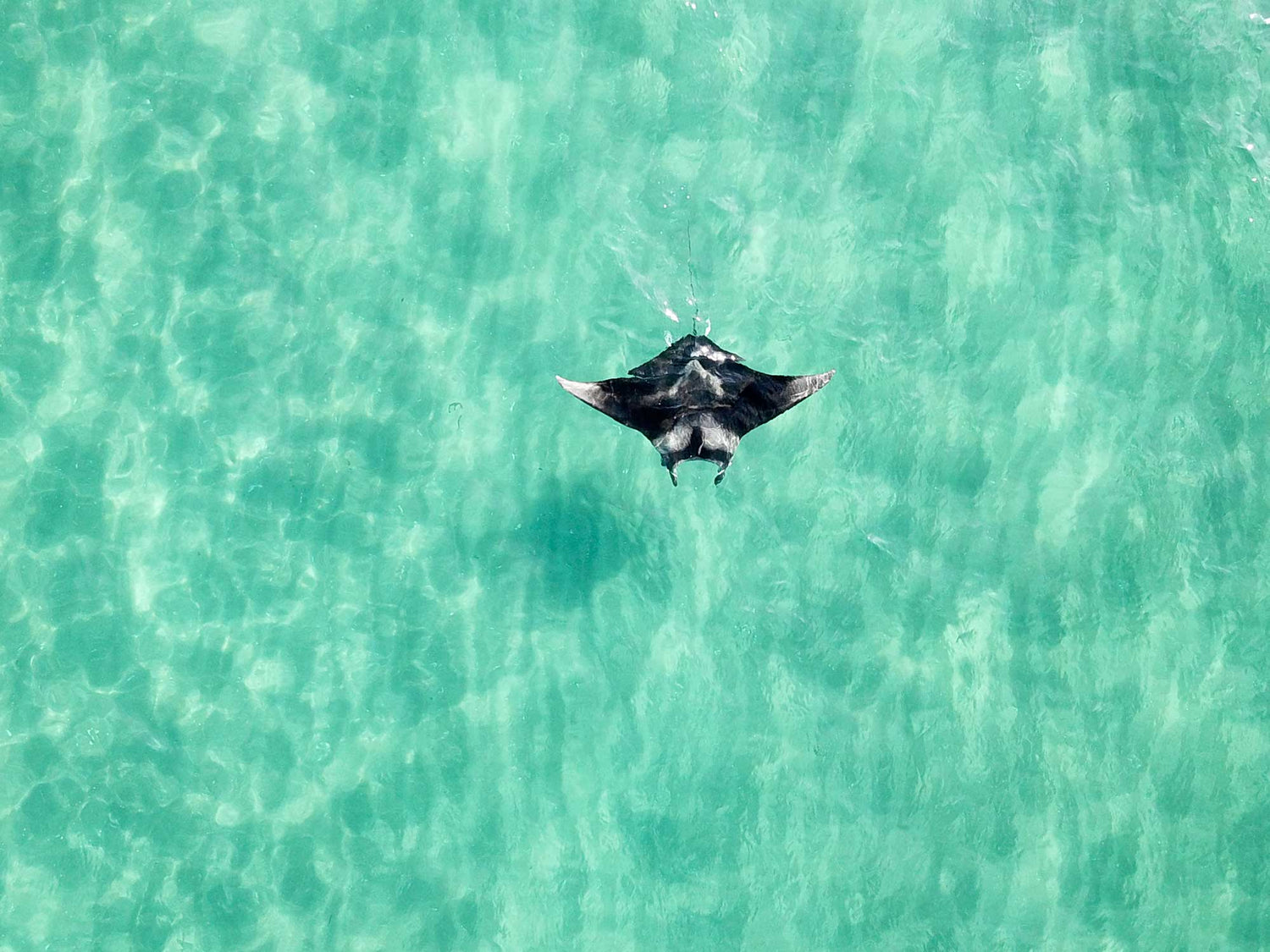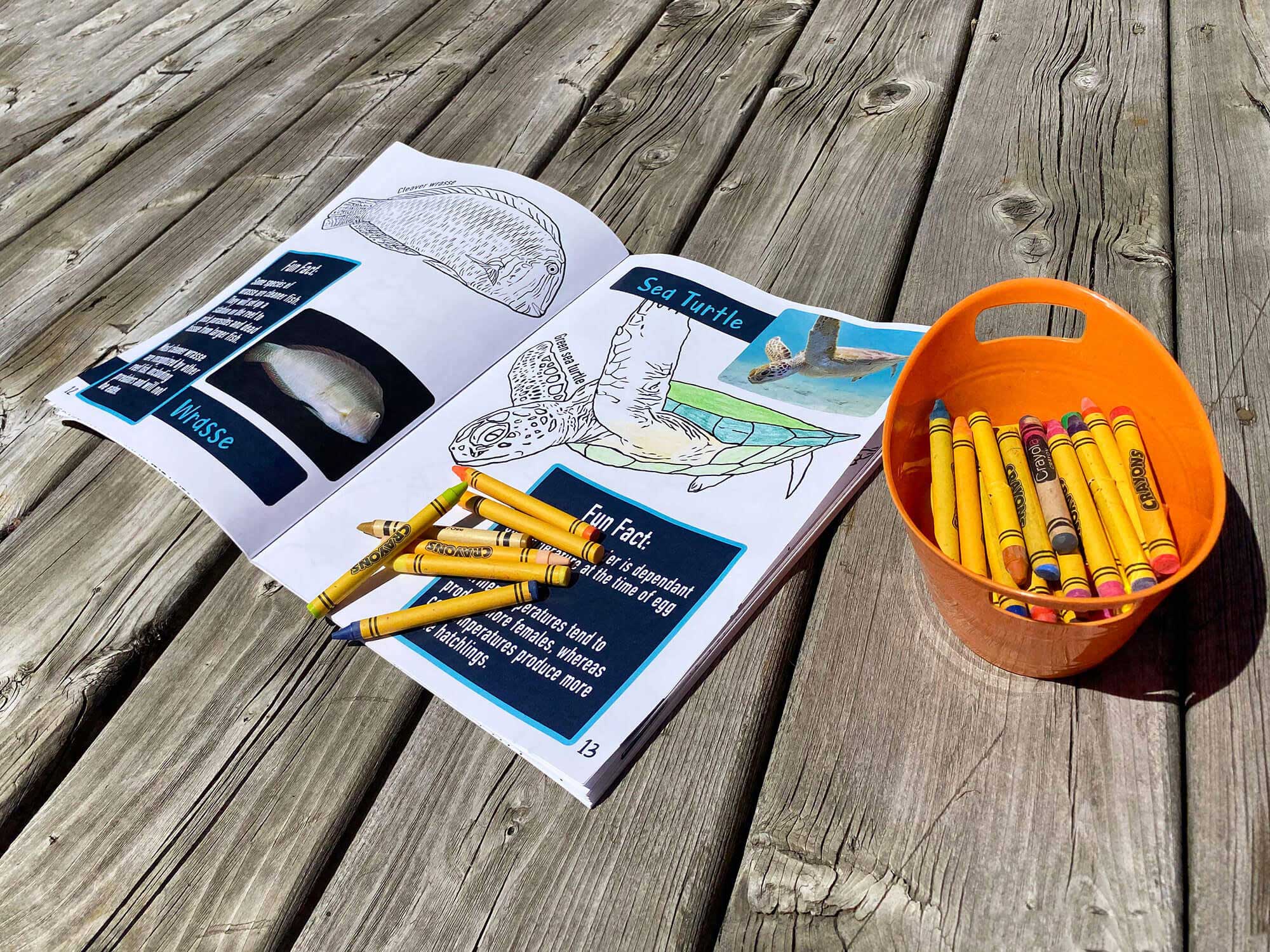Drone Image. A manta swims in shallow clear coastal water. Photo © 2020 Jessica Pate
By Bryant Turffs
In 2016, my partner, marine biologist Jessica Pate, and I began a small self-funded study of manta rays in South Florida. Oceanographic Magazine Issue 14 features an article entitled "Urban Nursery," which I wrote to chronicle our efforts and the project’s growth.
Many Floridans are unaware that mantas occur along our coasts. Even I believed they were rare visitors before we began this work. For Jessica, it was surprising that no one had ever undertaken a long term study of such a large and charismatic species in South Florida. As successes mounted over time the research became a full time pursuit for Jessica. Ultimately she partnered with the Marine Megafauna Foundation in expanding the project.

Near Miss. A recreational vessel passes a manta too close for comfort. Photo © 2020 Bryant Turffs
Now in its fifth year, the project has made some amazing discoveries and sparked new questions. Perhaps the most significant finding is that the vast majority of mantas in our study area are juveniles, making it a probable nursery habitat. A less welcome finding is that many of the manta rays suffer injury at the hands of humans, either through fishing line entanglement or boat strike.
Globally, mantas are considered vulnerable to extinction, and they were added to the US Endangered Species act in 2018. In addition to learning about the rays, The Florida Manta Project also conducts outreach and is collaborating with the National Oceanic and Atmospheric Administration to assist in conservation actions.
The Utility of Photography in Manta Research
Photography, both aerial and underwater, is one of the most powerful tools that we use in our research. When we began the work we relied on eyesight to spot manta rays from our boat. The first time flying a drone from the boat was a game changer. Our study subjects travel long distances and occur in low densities, so flying drones along the coast allows us to find them much more efficiently. Once a manta is located, video and still image capture from the air allows us to document behavior and any human interactions that occur for later analysis and use in conservation outreach. Jessica shares many of her most entertaining drone videos on Instagram @FloridaMantaGirl.

“Gillie" ID Shot. A good identification photo will capture the manta rays entire ventral side and clearly show the spot pattern. This photo shows individual nicknamed Gillie. Photo © 2020 Bryant Turffs
Each time a we locate a manta we also put a free diver in the water with an underwater camera. The camera allows us to document behavior and habitat for later analysis. More importantly it also allows us to identify and track individual mantas. All manta rays have a unique belly spot pattern, like a finger print. By identifying the same individuals across repeat encounters we can track movements and gain information about how long they use this nursery habitat. Repeat sightings of injured individuals also allows us to track the rate of healing. Fortunately, we have seen mantas survive and fully recover from severe injury.
Tips on Shooting Mantas Underwater
Since we began the research, I have used everything from a GoPro to a DSLR in these efforts. Today, I rely on my Canon EOS 7D Mark II and Ikelite 200DL underwater housing. I shoot either the Tokina 10-17mm f3.5-4.5 AT-X AF DX Fisheye or the Canon 10-22mm f3.5-4.5 USM lenses. The fisheye is great when I can get up close, capturing a huge field of view, and the Canon rectilinear wide angle provides more reach and less distortion, albeit softer image corners.
Our in water work is conducted solely while free diving, and is often fast paced, so my fallback settings are as follows:
- Ambient light only, as strobes create too much drag
- Center zone autofocus, with AF servo (continuous) to keep up with the pace and changing subject-camera distance
- Manual exposure mode, with a shutter speed of 1/320th (usually quick enough to freeze underwater movement) and an aperture of f/8
- Predominately Auto ISO as I am often uncertain if I will be shooting towards, across, or away from the light
- Center weighted average metering typically provides the best results in this mode
I recommend that anyone looking to travel in order to dive with mantas consider places like the Revillagigedo Archipelago (Socorro island), the Yucatan Peninsula in Mexico, or Manta Ray Bay Resort in Yap, Micronesia. Manta sightings are reliable in these locations and prolonged encounters allow you to savor the experience and make the most of photographic opportunities.

“Flip” in the shallows. We often sight mantas in shallow water and this individual, nicknamed Flip, was spotted in water about 3 feet deep! Photo © 2020 Bryant Turffs
Other Interesting Facts
Our South Florida study area is one of the few manta ray nursery habitats that has been identified in the world. It is unique in existing along a major human population center. Most other manta ray research projects focus on known aggregation sites like cleaning stations and feeding grounds where sightings are reliable.
The mantas in our study area occur at low densities and are driven to move over large distances by phenomena that are not yet fully understood. Our large local scuba diving community rarely sees these mantas on local reefs. Instead, most of our encounters occur in shallow nearshore waters right off beaches. While we have developed successful search techniques, manta encounters for most water users in South Florida are a rarity to be savored. Most of our encounters also only last a few seconds as a traveling ray passes us by. This always leaves me thirsty for more!

“Rikki” over Reef. This image shows an inquisitive manta, nicknamed Rikki, gliding over me. The local nearshore environment varies between sand, and limestone reef as shown here. Photo © 2020 Bryant Turffs
How You Can Help!
If you are lucky enough to encounter a manta here in Florida, or anywhere else in the world, you can help scientific research by submitting your ID photos. The Marine Megafauna Foundation maintains an online platform where you can share photos and details of the encounter. Citizen science efforts like this have contributed to real world conservation outcomes including the creation of marine reserves.
Follow along on Instagram @elusive_indeavors (Bryant) and Jessica @floridamantagirl (Jessica)

 Ambassador Bryant Turffs has worked on six of the seven continents as a biologist, boat captain, dive professional, commercial fisherman, photographer, and educator. Today he lives in Palm Beach County, Florida, and works with his partner, Jessica Pate, to understand the mysteries of the local manta ray population. He also uses his photography to tell other natural history and conservation stories. Read more...
Ambassador Bryant Turffs has worked on six of the seven continents as a biologist, boat captain, dive professional, commercial fisherman, photographer, and educator. Today he lives in Palm Beach County, Florida, and works with his partner, Jessica Pate, to understand the mysteries of the local manta ray population. He also uses his photography to tell other natural history and conservation stories. Read more...
Additional Reading
Oceanographic Magazine (Issue 14) featuring Bryant's Article
Shooting Manta Rays at Night Without a Strobe
Photographing Giant Mantas in Yap
The Marine Megafauna Foundation Finds a City-Dwelling Population of Young Mantas (Dive Magazine)
Big Manta Rays Found 'Right Under Our Nose' Off Florida Beaches (National Geographic)














![Freediving the Orca Trail with the PNW Protectors [VIDEO]](http://www.ikelite.com/cdn/shop/articles/pnw-protectors-orca-trail_3983eceb-6350-42a9-866b-ee499315e524.jpg?v=1645885027&width=1735)